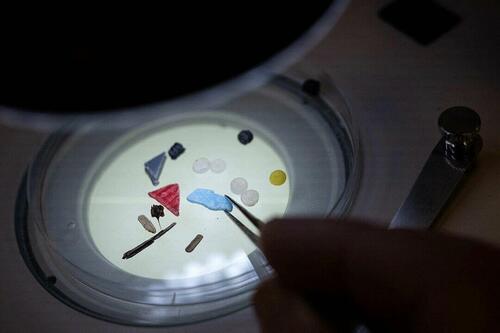Scientists Discover Toxic Microplastics in Every Human Placenta Tested in Study
Authored by Naveen Athrappully via The Epoch Times

Harmful microplastics have been found in the human placenta, with some of them known to trigger asthma, damage the liver, cause cancer, and impair reproductive function.
The peer-reviewed study, published in the Toxicological Sciences journal on Feb. 17, examined the issue of nano- and microplastic (NMP) pollution in human beings. Researchers found that all 62 tested placenta samples contained microplastics, with concentrations ranging from 6.5 to 790 micrograms per gramme of tissue. The placenta is an organ that develops in the uterus during pregnancy. It provides oxygen and nutrients to the baby while also removing waste products from the child’s blood.
The most prevalent microplastic found in the samples was polyethylene, which accounted for 54 percent of all detected NMPs and was “consistently found in nearly all samples.”
Polyethylene has been associated with several health complications, like asthma, hormone disruption impacting reproduction, and mild dermatitis or swelling and irritation of the skin.
Polyvinyl chloride (PVC) and nylon each represented approximately 10 percent of the NMPs by weight. PVC has been linked to damage to the liver and reproductive system. The substance is carcinogenic. While nylon itself is seen as harmless, the material undergoes chemical treatments during the manufacturing processes that can pose health risks.
The remaining 26 percent of microplastics found in the 62 tested placenta were represented by nine other polymers. Matthew Campen, Professor in the UNM Department of Pharmaceutical Sciences, who led the team that conducted the study, expressed concerns about the steadily rising presence of microplastics and its potential health implications.
While plastics themselves have traditionally been seen to be biologically inert, microplastics are so small they can cross cell membranes, he noted. Mr. Campen found the concentration of microplastics in the placenta troubling as the tissue was only eight months old when tested. “Other organs of your body are accumulating over much longer periods of time,” he said.
Mr. Campen believes the accumulation of microplastics in human tissue could explain the puzzling rise in certain health problems like colon cancer among people younger than 50, inflammatory bowel disease, and decreasing sperm counts.
“It’s only getting worse, and the trajectory is it will double every 10 to 15 years,” he said. “So, even if we were to stop it today, in 2050 there will be three times as much plastic in the background as there is now. And we’re not going to stop it today.”




